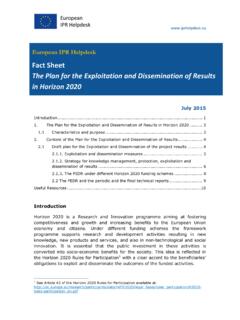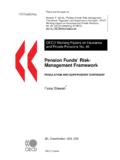Transcription of Fact Sheet How to manage confidential business information
1 European IPR Helpdesk Fact Sheet How to manage confidential business information June 20151. 1. 1. confidential information and trade secrets .. 2. 2. How to assess a trade secret .. 4. 3. Forms of protection .. 4. Remedies .. 5. 4. Trade secrets protection management .. 6. Identification of trade secrets .. 6. Store confidential information safely .. 7. Employee awareness .. 7. business partner commitment .. 9. Limits of trade 10. Useful Resources .. 11. Introduction In today's competitive market, companies need to be as innovative as possible to prosper in the business environment and to keep the pace with progress. To this end, the development and acquisition of useful information is crucial to create and provide new and improved goods and services.
2 information about technology that makes a company's product unique, prototypes, or a list of key customers are just a few examples of business information . As the latter can therefore have a great commercial value and significant importance for the company concerned, its uncontrolled disclosure might potentially lead to serious consequences. Small and medium-sized enterprises (SMEs) in particular may not be aware of this risk and thus of the importance of keeping this valuable information confidential . Indeed, such information relates to intangible assets and falls 1. This fact Sheet was first published in August 2012 and updated in June 2015. The European IPR Helpdesk under the category of intellectual capital, but its protection is not regulated within the intellectual property rights (IPR) system.
3 That is why confidential information belongs to the so-called Soft IP. The present fact Sheet will illustrate the importance of confidentiality for businesses and give hints on protection management of confidential business information , which could prove beneficial in particular to small and micro entities. 1. confidential information and trade secrets confidential information is considered as information that must be kept secret. While any information can be confidential , not all the information generated within a company must be kept secret. What is confidential is then judged by the company on the circumstances of each individual case, based on the necessity of it not being disclosed. confidential information may refer to personal information ( journals, pictures), professional information ( information supplied in the course of professional duties) and information in the context of business , commerce or trade ( trade secrets).
4 For the purpose of this document, we will focus on trade secrets. As it can be seen from the below diagram, trade secrets are confidential information related to the business and can be somewhat synonymous with know-how2. In practice however all these terms are often used interchangeably. confidential information . business Professional Personal information information information trade secrets know-how Broadly speaking, trade secrets are any confidential business information which provides an enterprise with an economic benefit that translates into competitive advantage3, and this directly derives from the fact that the secret is generally 2. Although know-how does not necessarily require secrecy, it acquires trade-secret status only if it is secret and has economic value and if measures are in place to secure its secrecy.
5 Know-how becomes IP and is protected only if it qualifies as a trade secret. 3. Some of the most common trade secrets are the Coca-Cola recipe, the Google algorithm and the New York Times Best Seller List. Although they are now large companies they started as SMEs and it is thanks to such trade secrets that they have become successful. 2. The European IPR Helpdesk unknown to competitors due to the efforts of its owner to keep it secret. In this sense, protection of trade secrets give incentive to innovate by safeguarding the substantial time and capital invested to develop innovations. They are critical to the functioning of a company and any unauthorised or accidental disclosure of trade secrets may destroy their confidential status and may cause a considerable economic loss for the business4 concerned.
6 If not protected, competitors could use this information without having to bear the costs or risks and the owner of the trade secret would certainly lose the competitiveness built on this information . Trade secrets are relevant for example when a product or process is not considered worth a patent or is not patentable at all, as well as an alternative option to patenting5. Yet, they also play a fundamental role before seeking a patent. During this period in fact, disclosure of patent features may destroy patentability. Given its non-material nature and economic value, all this information belongs to a company's intangible assets. However, since trade secrets are a peculiar form of intellectual property (IP)6, they require an appropriate internal management programme.
7 Any entrepreneur should put in place a safeguard system within its company for protection of trade secrets to be effective. This would require goodwill and maintenance7, which in some cases is the most fruitful IP protection. Indeed, a trade secret offers a broader scope of protection than other forms of IPR as, once the very low requirements are met, any information related to technology, design, art, marketing, idea, concept and so forth, can be protected. Moreover, trade secrets are much cheaper than IPR as they need no registration or any official procedure to be protected and, most importantly, as long as secrecy is kept they are effective without time limits. Therefore, the term of protection can be perpetual as regards trade secrets.
8 4. An interesting case related to Ford Motor Co. An engineer of the company copied thousands of Ford's documents onto an external drive and went to work for a competitor. It was estimated that Ford suffered more than $50 million in losses. 5. There can be some circumstances that may justify avoiding a patent. As an example, you offer a financial consulting service based on an evaluation market method. If you patented this method, competitors would be likely to revers it without any trace of infringement. In that case you will lose your competitiveness, thing that would not happen if you keep the method as a trade secret. 6. confidential information is not property like other forms of IP. Nevertheless, the Court of Justice of the European Union in its Microsoft judgment, Case T-201/04, and the European Commission in its Regulation 772/2004, Article , have stated that trade secrets should be treated as equivalent to intellectual property rights.
9 7. Practical examples of measures that should be considered to protect a company's trade secret are provided in paragraph 4 of this fact Sheet . 3. The European IPR Helpdesk 2. How to assess a trade secret For information to be legally protected as a trade secret it must: Be unknown to the business circles that normally deal with that kind of information ;. Confer some sort of economic benefit because it is secret;. Be the result of reasonable efforts to maintain its secrecy. Some information qualifying as a trade secret: information relating to formulas, patterns, devices or other compilation of information that is used for a considerable period of time in a business ( Coca- Cola recipe);. Technical information used in the manufacturing process for production of goods, including software used for various business purposes ( the ZARA's IT system to shorten the production cycle).
10 Marketing, export or sales strategies, or a method of bookkeeping or other business management routines or procedures ( list of key suppliers and/or buyers). Other information may include financial information ( business plans), purchase prices of key raw materials, list of key customers, product specifications, test data, technical drawings or sketches, engineering specifications, contents of workbooks8, the salary structure of a company, any kind of agreement, promotional or marketing material under development, and the like. 3. Forms of protection Trade secrets do not confer apposite proprietary rights , as it is the case with other IPR. Although at national level there is a long standing tradition of trade secrets protection ( Italy, Germany, Bulgaria, France and UK), in the EU there is no harmonisation9.


